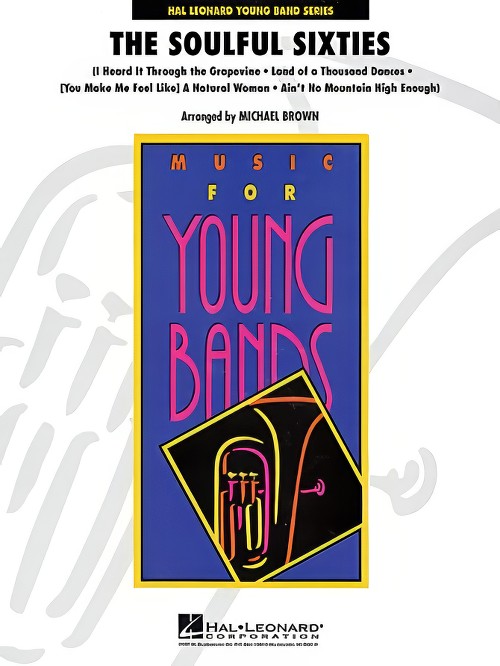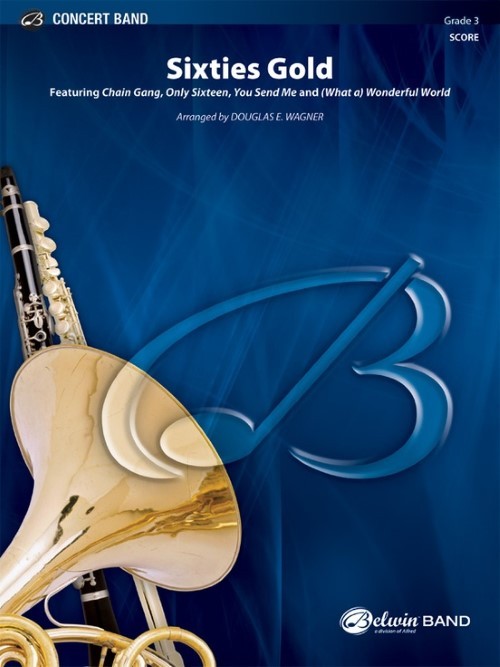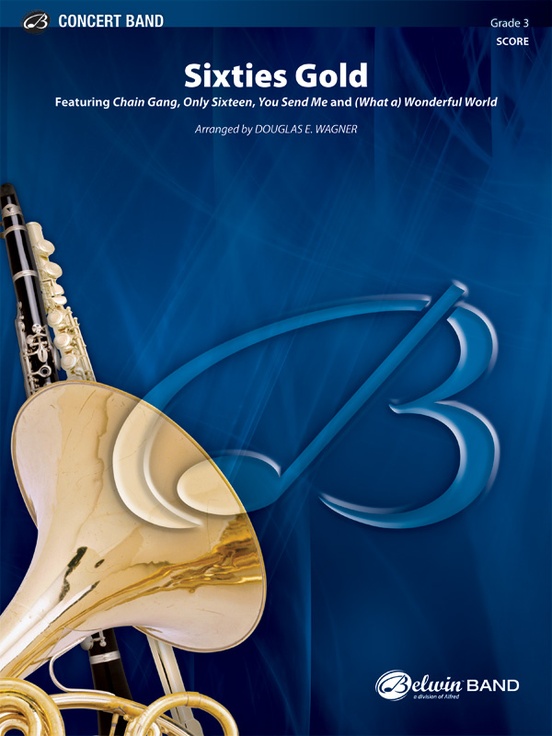Results
-
 £104.99
£104.99The Golden Sixties
The 1960s is one of the most fascinating eras in the history of popular music. Many great hits from then have been turned into new versions during later decades after initial success. But everyone, both young and old, remembers the original songs well. Richard Johnsen has made great arrangements of You Can't Hurry Love, Son-of-A-Preacher Man, Stand By Me and Think, for this spectacular medley, The Golden Sixties.
Estimated dispatch 7-14 working days
-
 £62.95
£62.95 -
 £64.99
£64.99The Soulful Sixties
The music of the '60s was just about as diverse as musically imaginable. And in the midst of it all, Motown continued to crank out hit after hit of catchy rhythm-based tunes. Here is a medley that is sure to be enjoyed by all agesthat includes: I Heard It Through the Grapevine, Land of a Thousand Dances, (You Make Me Feel Like) A Natural Woman and Ain't No Mountain High Enough.
Estimated dispatch 7-14 working days
-
 £64.99
£64.99The Soulful Sixties (Concert Band - Score and Parts) - Brown, Michael
The music of the '60's was just about as diverse as musically imaginable. And in the midst of it all, Motown continued to crank out hit after hit of catchy rhythm-based tunes. Here is a medley that is sure to be enjoyed by all ages that includes:I Heard It Through the GrapevineLand of a Thousand Dances(You Make Me Feel Like) A Natural WomanAin't No Mountain High EnoughDuration: 5.00
Estimated dispatch 7-14 working days
-
 £62.95
£62.95Sixties Gold (Concert Band - Score and Parts) - Wagner, Douglas E.
Chocked full of style, the medley includes "Chain Gang," "Only Sixteen," 'You Send Me" and "What a Wonderful World." These Sam Cooke tunes are both familiar and revered. Quite honestly a legitimate part of our musical heritage. Comfortably scored at the concert band level by Douglas Wagner, join the fun with this charming musical stroll through the 60s. Duration: 4.45
Estimated dispatch 7-14 working days
-
 £62.95
£62.95Sixties Gold
Chocked full of style, the medley includes "Chain Gang," "Only Sixteen," 'You Send Me" and "What a Wonderful World." These Sam Cooke tunes are both familiar and revered. Quite honestly a legitimate part of our musical heritage. Comfortably scored at the concert band level by Douglas Wagner, join the fun with this charming musical stroll through the 60s. (4:55)
Estimated dispatch 3-5 working days
-
 £109.99
£109.99Tom Jones in Concert
Having scored many hits over a long career, especially in the sixties and seventies, Tom Jones remains a world star. Gilbert Tinner has now created a fantastic and easily playable arrangement with songs from this period. This medley includes She's a Lady, It's Not Unusual, Delilah and Help Yourself.
Estimated dispatch 7-14 working days
-
 £113.30
£113.30Moderate Dances - Angelo Sormani
This piece is a tribute to dance music, especially passionate, intense and meditative dance music. "Moderate Dances" is divided into three movements: a "Tango", a "Slow Waltz" and a "Bossa Nova". Each movement and each dance has its own particular characteristics but, when combined, these different rhythmic beats and times give the piece a feeling of completeness and uniformity. The Tango started to flourish in the suburbs of Buenos Aires in around 1880. There is still some doubt as to its origins, which may be Cuban (Habanera) but are probably African. It was most popular in Argentina and Brazil: here the male protagonist was originally the "gaucho" with his inseparable guitar, later to be replaced by the proud, elegant "compadre". By around 1910 the Tango had spread to Italy and France. New clubs opened, where the upper classes could watch and dance the Tango. Here the dance also underwent some rapid transformations. The exaggerated and extravagant gestures and body movements disappeared. Slow, gliding steps replaced the old rotational movements. The women's red ankle-boots and the partners "staring into each other's eyes" accentuated the erotic nature and sensuality of this dance. So much so that, in 1913, the German government banned soldiers from dancing the Tango. Those who broke the law were immediately discharged from the army. From a strictly musical perspective, the basic instruments were a flute, a harp (the diatonic harp typically played by the Indians of Paraguay) and a violin, or flute, guitar and violin or even clarinet, guitar and violin. These instruments were easy to transport, ideal for playing at parties, in the streets and in courtyards. The musicians played by ear, frequently improvising: there were no scores, no records, which is the main reason why it is impossible to trace the Tango back to its exact origins. However, the Tango's evolution (and growing popularity) was once again fostered by its fundamental ability to absorb "other" cultures, languages and sounds. And it was the arrival of the "bandoneon" (an accordion-like instrument that was invented in Germany and brought to Rio de la Plata by some immigrant), which replaced the flute, that marked the beginning of the Tango's huge success outside Argentina. A number of talented composers, above all the great Astor Piazzola (1921-1992), transformed the bandoneon from a simple accompanying instrument to a solo instrument that was to become the distinguishing feature of the 20th century Tango. The Slow Waltz originated from the Waltz, the typical dance of the Bavarian and Tyrolese peasants in the 1700s. It was composers like Johann Strauss, father and son, who carried the Waltz to its zenith in the 1800s, creating the sensual and melancholy yet joyful and charming dance we are all familiar with. When the Waltz first became popular in Germany, the members of respectable society were shocked at the closeness of the dancing partners, who had always previously danced apart. The main difference between the Waltz and Slow Waltz is that the latter has a slower, more expressive rhythm: the men wear tails and the women wear ball gowns decorated with beads and feathers and couples dance in graceful rotational movements. "Bossa Nova" is the title of the last movement in the piece. Jobim, the great Brazilian musician, described this musical genre as a combination of modern Jazz and Samba. Bossa Nova means "new wave". This was the name of the artistic and musical movement that evolved in Brazil in the late Fifties and was extremely popular throughout the Sixties. The songs are usually about love or social matters, drawing inspiration from the slums of Rio De Janeiro and the lives of their inhabitants. Bossa Nova, with its original compositions and the artistic talent of its musicians, also became hugely popular in the United States and Europe, and top Jazz musicians (Ella Fitzgerald, Stan Getz, Bob Cooper, Charlie Bird, Sonny Rollins, Dexter Gordon, Dizzy Gillespie) started to include Bossa in their repertoires.
Estimated dispatch 7-14 working days
-
 £72.99
£72.99Crystal Waves - Stef Minnebo
During the first half of the sixties the world was under the spell of Californian surf music. Groups such as the Beach Boys, Dick Dale and his Del- Tones, The Surfaris and The Challengers dominated the international charts. The summery and happy style was very catchy, and as it turned out had a great influence on early rock music. Crystal Waves is an ode to this surf music and utilises its characteristic melodies, chords and rhythms to form a catchy piece for concert band.
Estimated dispatch 7-14 working days
-
 £102.99
£102.99Remember The '60
Albert Miles has made a good playable arrangement of a selection of the best known numbers of the Sixties, "The Good Old Days of Rock & Roll!!" This medley with sections from "Rock Around The Clock", "Shake, Rattle & Roll", "Mona Lisa", "Are you Lonesome Tonight" and "Jailhouse Rock" will make it difficult for your audience to stay in their seats.
Estimated dispatch 7-14 working days
